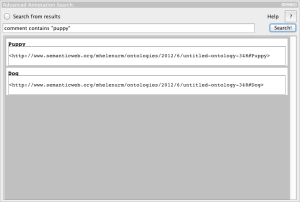Difference between revisions of "Advanced Annotation Search"
(→Usage Guide) |
(→Usage Guide) |
||
| Line 22: | Line 22: | ||
=== Operators === | === Operators === | ||
| + | |||
| + | table | ||
| + | |||
| + | === Logical Operators === | ||
| + | |||
| + | table | ||
| + | |||
| + | === Examples === | ||
| + | |||
| + | lots of text | ||
Revision as of 17:16, July 17, 2012
Advanced Annotation Search
A search function to find entities based on annotation data.
Contents
Versions & Compatibility
This section lists available versions of Advanced Annotation Search.
| Version | Compatible with | Dependencies |
|---|---|---|
| Advanced Annotation Search 1.0.1 |
If you click on the button below to add a new version of Advanced Annotation Search, you will be asked to define a page title for the new version. Please adhere to the naming convention of Advanced Annotation Search X.X.X when you define the new page!
Changelog
| Version | Changes in this version |
|---|---|
| Advanced Annotation Search 1.0.1 | Initial Release |
Usage Guide
Basic Syntax
Expressions you type in the text field are broken down into "terms". A term is either a single word, or an item separated by quotation marks (""). For a basic search, you can type a single term into the box (e.g. "dorsal fin" or puppies). For a more complex expression, you use groups of three terms (called triples), which are broken down into the annotation type, the operator, and the search term. For example, if you want all comment annotations that contain the term "dermal bone", you would search: comment contains "dermal bone". If you want to search for an even more complex expression (for example, you know the comment annotation contains the phrase "phenoscape" and the age annotation is greater than 19), you break the two search terms up with a logical operator (and, or, exclusiveor). So in this example, your search string would be: comment contains phenoscape and age > 19.
Operators
table
Logical Operators
table
